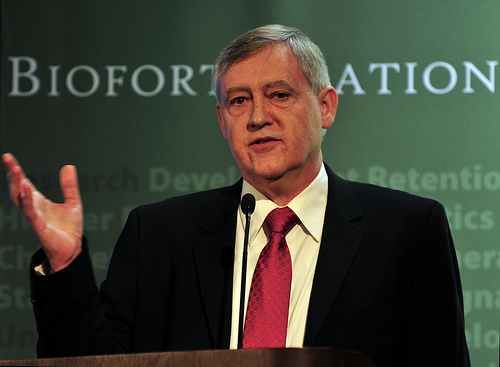“Malnutrition is the single biggest global health problem in the world,” Ambassador William J. Garvelink, the deputy coordinator for development of President Obama’s new Feed the Future initiative announced at the First Global Conference on Biofortification last week in Washington, DC. Global experts gathered in Georgetown to discuss the future of this worldwide initiative to reduce “hidden hunger” or micronutrient malnutrition, which affects at least 1 billion people worldwide, causing a variety of illnesses and mortality in the developing world.

HarvestPlus director Howarth Bouis (photo credit Neil Palmer CIAT)
Biofortification is the process of breeding higher levels of essential micronutrients, such as Vitamin A, iron, and zinc, into the staple crops that provide nourishment to vulnerable people, particularly women and children. Keynote speakers, panelists and white paper authors spoke to an audience of scientists, policymakers, donors and business leaders from around the world to facilitate conversation about breakthroughs and research in the industry. Recent discoveries show, for example, that biofortified orange sweet potato can be effective in providing dietary vitamin A. Vitamin A deficiency is a leading cause of preventable blindness in children and also increases risk of maternal mortality.
“Food security is about ensuring better access to better quality food and creating innovative linkages between health and agriculture,” said Garvelink. One of the main topics of discussion on the first day of the conference was a need to strengthen the link between nutrition and agriculture.
Unfortunately, the fact that agriculture is a primary source of essential minerals and vitamins for humans is often ignored and lost in talk of agribusiness, biofuels, subsidies and feeding the growing population. Meera Shekar, Lead Health and Nutrition Specialist with Human Development Network at the World Bank, pointed out that according to the private sector “food is a need, nutrition is a want.” She went on to explain that a lack of food is a visible travesty, but lack of nutrition and the health issues that stem from it is often invisible, and she stressed the importance of making nutrition more visible to decision makers. Nutrition needs, she noted, should be the prime driver of agriculture because they can be used to fix malnutrition.
The keynote speeches and presentation panels were supplemented by afternoon workshops, in which conference attendees could choose to attend more informal discussions on the specifics of progress, challenges and delivery of different biofortified crops, how to build public trust in these crops, and the integration of biofortification into the global development agenda such as the Millennium Development Goals, and regional and national planning strategies.
The conference was organized by HarvestPlus, a research organization that seeks to reduce hidden hunger and provide micronutrients to billions through the staple foods they eat. HarvestPlus Director Howarth Bouis made the specific point that in the “long term goal is to improve incomes and diversify diets” to alleviate malnutrition. They realize, however, that in the meantime it is crucial to put more nutrients into what the poor do eat, and with rising food prices the poor now spend more of their incomes on staple foods and less on high nutrient meats, fruits, and vegetables. Through biofortification they are targeting the poor who eat staples crops like rice, cassava, and sweet potatoes.

Danielle Nierenberg, an expert on livestock and sustainability, currently serves as Project Director of State of World 2011 for the Worldwatch Institute, a Washington, DC-based environmental think tank. Her knowledge of factory farming and its global spread and sustainable agriculture has been cited widely in the New York Times Magazine, the International Herald Tribune, the Washington Post, and
other publications.
Danielle worked for two years as a Peace Corps volunteer in the Dominican Republic. She is currently traveling across Africa looking at innovations that are working to alleviate hunger and poverty and blogging everyday at Worldwatch Institute’s Nourishing the Planet. She has a regular column with the Mail & Guardian, the Kansas City Star, and the Huffington Post and her writing was been featured in newspapers across Africa including the Cape Town Argus, the Zambia Daily Mail, Coast Week (Kenya), and other African publications. She holds an M.S. in agriculture, food, and environment from Tufts University and a B.A. in environmental policy from Monmouth College.








